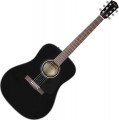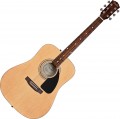Anchor
The type of truss provided in the guitar neck design.
The truss rod is a long metal rod located inside the neck of the guitar (along it). It is designed to provide the desired stiffness and prevent neck distortion due to string tension. This function is relevant for models that use metal strings — primarily acoustic ones (see "Type"); Nylon guitars don't need an anchor.
Often it is possible to adjust the tension force of the anchor — to change the degree of deflection of the neck. This can be useful both for adjusting to the guitarist's preferences and for correcting neck distortion that develops over time.
Note that the lack of information on the anchor does not mean the absence of the latter: some manufacturers simply do not bother to mention it in the basic data on the tool. So in such cases, you can try to find more detailed information on the selected model.
Specific options for the anchor can be as follows:
— Single. An anchor in the form of a single rod is the simplest and most inexpensive option. At the same time, the strength and rigidity of such a rod is sufficient in most cases.
— Double. Twin anchor, consisting of two rods. A pair of rods provides increased strength and reliability compared to a single truss rod, and also provides additional protection against lateral deformations of the fingerboard (deviations to the right / left). At the same time, a double anchor is not cheap, despite the fact...that the described advantages are really important only in professional music, where even the slightest deviations from the reference sound are unacceptable. Therefore, the double anchor is found mainly in premium tools.
— Is absent. The complete absence of an anchor in the design of the neck. Despite the useful properties of this part, its use is far from always justified: for example, the neck can be made of durable and elastic materials that “work” well without additional reinforcement. Another reason for the one-piece construction is that mounting a metal rod disrupts the neck's uniformity and can degrade the instrument's acoustic performance, which can be critical on high-end models. Note that the absence of an anchor is separately indicated only for acoustic guitars and other instruments with metal strings; in "nylon" models, rods are not used by definition, and there is no need to specifically specify its absence.
Neck material
The material from which the neck of the guitar is made — more precisely, the base of the neck (the fretboard can be made from another material). Now the most commonly used materials are:
nato,
maple and
mahogany. For the value of this parameter, see p. "Top deck".
Strap
The presence of a
belt in the tool kit.
The strap allows you to hang the guitar on your shoulder. This not only gives the guitarist additional options when playing (for example, you can comfortably play while standing), but it can also be useful for transporting the instrument — you can hang it behind your back, freeing your hands (although in this case it doesn’t hurt to make sure the strap is secure). Straps are also sold separately, but the complete accessory, by definition, is optimally suited for the guitar, and besides, you don’t need to spend additional time and effort to buy it.
Picks
Picks included with the guitar.
The pick is a small plate that the guitarist uses to pick the sound from the strings. In this way, you can get a brighter, clearer and more sonorous sound than when playing with your fingers (both on notes and on chords); therefore, many musicians prefer to use picks.
Picks can vary in stiffness; The best option depends primarily on the preferences of the guitarist. Thus, guitars, if they are equipped with picks, then, usually, several at once — this allows the musician to choose the most suitable option.

